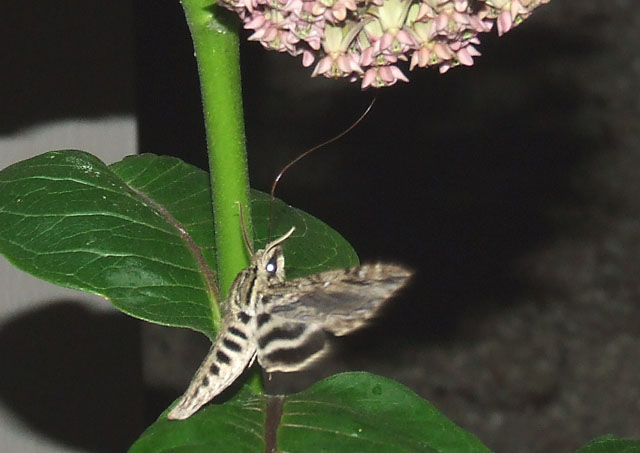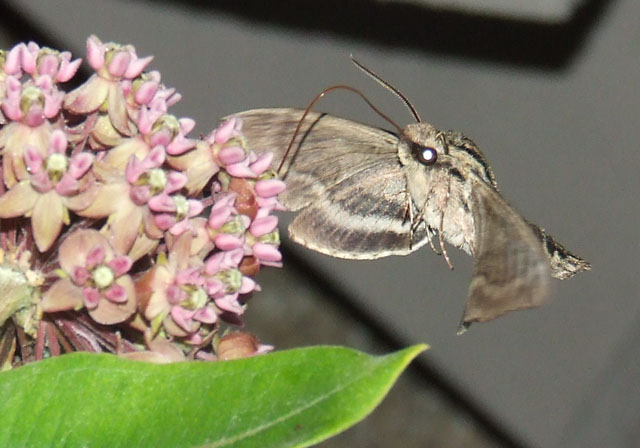Sphinginae subfamily
Sphingini tribe:
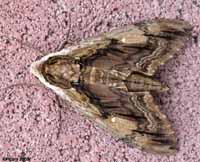 |
Ceratomia amyntor
WO,
the Elm Sphinx or Four-horned Sphinx
The upperside of the forewing is brown with dark brown and white
markings including a white costal area near the wing base,
dark streaks along the veins, and a white spot in the cell.
Larvae feed on Elm (Ulmus), birch (Betula), basswood (Tilia), and
cherry (Prunus).
|
 |
Ceratomia undulosa
USGS,
the Waved Sphinx.
The upperside of the forewing is pale brownish gray (occasionally quite dark) with wavy black
and white lines and a black-outlined white cell spot. The upperside
of the hindwing is gray with diffuse darker bands.
|
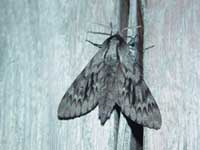 |
The upperside of the forewing is gray with heavy black bands.
The upperside of the hindwing is brownish gray with no markings.
Larvae feed on pines.
|
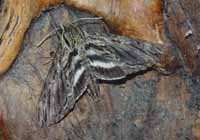 |
This species is confirmed for Door County by David Link.
Generally it is not widely reported.
Larval hosts are various species of beebalm (Monarda), mints (Mentha), bugleweed (Lycopis),
and sage (Salvia). |
Sphinx eremitus adults nectaring at dusk on milkweed
July 17, 2007, courtesy of David Link.
Lintneria eremitus,
Gibraltar, larva and pupa: October 10, 2003, December 5, 2003; adult moth: June 23, 2004, courtesy of
Janice Stiefel.
 |
This large bodied moth flies in tobacco fields and vegetable gardens
(potatoes, tomatoes) and wherever host plants are found.
|
Manduca quinquemaculatus,
Bailey's Harbor, July 30, 1999, courtesy of
Janice Stiefel.
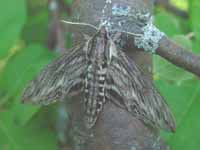
|
Sphinx canadensis
USGS/JS,
Sphinx canadensis, the Canadian Sphinx, is not common, and is not
often reported anywhere,
but it is present in Door County.
Larval hosts are white ash (Fraxinus americana) and blueberry
(Vaccinium).
|
Sphinx canadensis,
Bailey's Harbor, July 16, 2001, courtesy of
Janice Stiefel.
 |
Sphinx chersis
WO/JS, the Northern Ash Sphinx or Great Ash
Sphinx The upperside of the forewing is soft dark gray to blue-gray
with a series of black dashes, one of which reaches the wing tip.
|
Sphinx chersis larva and adult moth,
Gibraltar, August 5, 2002, courtesy of
Janice Stiefel.
 |
This species is present and probably flies
in May/June and August. We have them on P.E.I., but I do not see them
nearly as frequently as I see the other Sphingidae. |
Sphinx drupiferarum,
Gibraltar, May 20, 2003, courtesy of
Janice Stiefel.
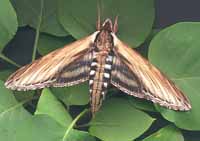 |
The lower forewings are predominantly brownish-yellow with a
fairly wide dark bar along the inner margin. At rest the wings
hug the body, giving the moth a long slender look.
|
Sphinx kalmiae,
Bailey's Harbor, July 16, 2003, courtesy of
Janice Stiefel.
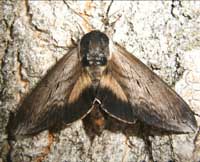 |
Sphinx luscitiosa
WO/TB,
the Canadian Sphinx or
Clemen's Sphinx:
The upperside of the forewing is yellowish gray in males and pale
gray with a faint yellow tint in females. In both sexes, the dark
border on the outer margin widens as it approaches the inner margin.
|
Sphinx luscitiosa male, 6:05pm, July 3, 2012, courtesy of Tim Borski.
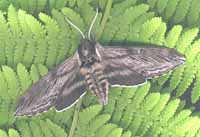 |
If you have blueberries in the woods, then you probably have the
Poecila Sphinx. They are probably widespread throughout Wisconsin,
but are very much under reported. |
Sphinx poecila,
Bailey's Harbor, June 13, 2003, courtesy of
Janice Stiefel.
Smerinthini Tribe:
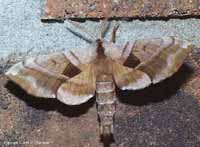 |
The adults are also highly variable; sometimes wings of an
individual may be all one color or may have several colors,
ranging from pale to dark brown, and may have a white or pink tinge.
See the file for the female; she is different.
|
 |
The outer margin of the forewing is quite wavy. There is a dark cell
spot and a dark oblique line mid wing from the costa almost to the
inner margin. Basic ground colour is pinkish brown. Flight would
be June-July.
|
 |
Paonias myops
WO/JS,
the Small-eyed Sphinx
This small species is confirmed in Door County by Janice Stiefel.
This species ranges across North America.
The hindwings have a small blue eyespot ringed with black on a yellow
background.
|
Paonias myops Bailey's Harbor, August 6, 2004,
courtesy of
Janice Stiefel.
 |
Pachysphinx modesta
USGS,
the Modest Sphinx or Poplar Sphinx,
This large poplar/willow feeder is reported in Door County.
They are a heavy bodied species.
|
 |
Smerinthus cerisyi
USGS/JS, the Cerisyi's
Sphinx or One-eyed Sphinx, Larvae feed on poplars and willows.
Flight would be from late May-July as a single brood.
|
Smerinthus cerisyi,
Bailey's Harbor, June 6, 2001, courtesy of
Janice Stiefel.
 |
This moth is widely distributed and fairly common, and is
now officially
recorded in Door County.
Along the East Coast, it flies from P.E.I. to Florida.
|
Smerinthus jamaicensis,
Bailey's Harbor, May 23, 2003, courtesy of
Janice Stiefel.
Macroglossinae subfamily
Dilophonotini Tribe:
See Hemaris comparison to help distinguish
the next three species.
 |
Hemaris diffinis
WO, the Snowberry Clearwing or Bumblebee Moth,
The moth flies along forest edges and in meadows, gardens and
brushy fields. Day-flying adults nectar at lantana, dwarf bush honeysuckle,
snowberry, orange hawkweed, thistles, lilac, Canada violet, etc.
|
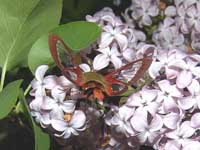 |
Hemaris gracilis
WO, The Slender Clearwing or Graceful
Clearwing
This day flier is not commonly reported, but it might be present in
Door County. unlikely
|
 |
Hemaris thysbe
WO/JS, the Hummingbird Clearwing
This interesting day flier is confirmed for Door County by Janice Stiefel.
They are widely distributed in the east from P.E.I. to Florida.
|
Hemaris thysbe, July 2002 larva to May 2003 moth, courtesy of Janice Stiefel.
Philampelini Tribe:
 |
This moth is not reported for Door,
but it may be present.
Note the differences between this moth and the Pandorus Sphinx.
|
 |
The Gaudy Sphinx flies in America, and although primarily a tropical
species, it has been taken as far north as Saskatchewan as a stray.
Forewings are a vibrant grey-green. Rare fall stray to
Wisconsin
|
Eumorpha labruscae,
Newport State Park, October 2, 2007, courtesy of
Janice Stiefel.
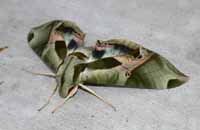 |
If you have Grape or Virginia Creeper nearby, then you probably have
this species. I often get asked to identify larvae from areas where
they have not previously been reported. |
Macroglossini Tribe:
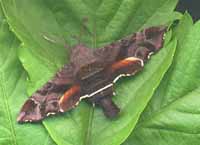 |
This day flier is widely distributed. If you have Virginia Creeper,
you probably have the Nessus Sphinx. Two bright, distinct, narrow
yellow bands are often visible on the abdomen.
|
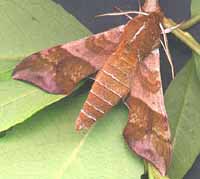 |
They are common in New Jersey and common
here on Prince Edward Island.
You will often see this species listed as Darapsa pholus,
especially in older literature.
|
Darapsa choerilus,
Bailey's Harbor, July 2, 2003, courtesy of
Janice Stiefel.
 |
Darapsa myron
WO/JS, the Virginia Creeper Sphinx or the
Grapevine Sphinx
This moth is not recorded on the U.S.G.S. site for Door County, but
Janice Stiefel confirms its presence there via a found larva that
overwintered in pupal stage
and emerged the following spring.
It is widely reported in southern Michigan and in southern Ontario.
|
Darapsa myron,
Bailey's Harbor, May 18, 2003, courtesy of
Janice Stiefel.
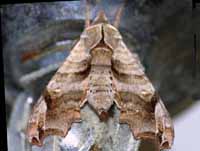 |
This species has not been recorded in Door.
It is seen in southern Ontario, however, and in central and
southern Wisconsin. |
 |
Hyles gallii
WO, the Bedstraw Hawk Moth
or Gallium Sphinx
This species is not reported in Door, but it has been recorded in
other eastern Wisconsin counties. I suspect it is present.
Some years I see them on P.E.I., some years, I do not.
|
 |
Hyles lineata
WO, the White-lined Sphinx
Adults usually fly at dusk, during the night, and at dawn, but they
also fly during the day over a wide variety of open habitats
including deserts, suburbs, and gardens. |
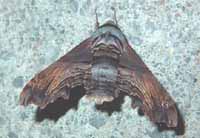 |
This moth is very much under reported on USGS. It is a
rapid day flier so is probably not in too many collections.
Grape is a popular larval host.
|
Sphecodina abbottii,
Gibraltarr, July, 21, 2002, larva, subsequent moth
on April 25, 2003, courtesy of
Janice Stiefel.
|
|



